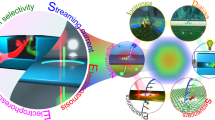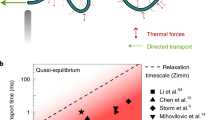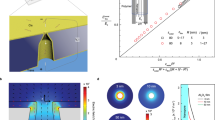Abstract
Despite gel electrophoresis being one of the main workhorses of molecular biology, the physics of polyelectrolyte electrophoresis in a strongly confined environment remains poorly understood. Theory indicates that forces in electrophoresis result from interplay between ionic screening and hydrodynamics1,2, but these ideas could so far be addressed only indirectly by experiments based on macroscopic porous gels. Here, we provide a first direct experimental test by measuring the electrophoretic force on a single DNA molecule threading through a solid-state nanopore3 as a function of pore size. The stall force gradually decreases on increasing the nanopore diameter from 6 to 90 nm, inconsistent with expectations from simple electrostatics and strikingly demonstrating the influence of the hydrodynamic environment. We model this process by applying the coupled Poisson–Boltzmann and Stokes equations in the nanopore geometry4,5 and find good agreement with the experimental results.
This is a preview of subscription content, access via your institution
Access options
Subscribe to this journal
Receive 12 print issues and online access
$259.00 per year
only $21.58 per issue
Buy this article
- Purchase on SpringerLink
- Instant access to full article PDF
Prices may be subject to local taxes which are calculated during checkout




Similar content being viewed by others
References
Long, D., Viovy, J. L. & Ajdari, A. Stretching DNA with electric fields revisited. Biopolymers 39, 755–759 (1996).
Viovy, J. L. Electrophoresis of DNA and other polyelectrolytes: Physical mechanisms. Rev. Mod. Phys. 72, 813–822 (2000).
Keyser, U. et al. Direct force measurements on DNA in a solid-state nanopore. Nature Phys. 2, 473–477 (2006).
Ghosal, S. The effect of salt concentration on the electrophoretic speed of a polyelectrolyte through a nanopore. Phys. Rev. Lett. 98, 238104 (2007).
Ghosal, S. Electro-kinetic-flow-induced viscous drag on a tethered DNA inside a nanopore. Phys. Rev. E 76, 061916 (2007).
Kasianowicz, J., Brandin, E., Branton, D. & Deamer, D. Characterization of individual polynucleotide molecules using a membrane channel. Proc. Natl Acad. Sci. USA 93, 13770–13773 (1996).
Meller, A., Nivon, L. & Branton, D. Voltage-driven DNA translocations through a nanopore. Phys. Rev. Lett. 86, 3435–3438 (2001).
Li, J. et al. Ion-beam sculpting at nanometre length scales. Nature 412, 166–169 (2001).
Li, J., Gershow, M., Stein, D., Brandin, E. & Golovchenko, J. DNA molecules and configurations in a solid-state nanopore. Nature Mater. 2, 1611–1615 (2003).
Chang, H. et al. DNA-mediated fluctuations in ionic current through silicon oxide nanopore channels. Nano Lett. 4, 1551–1556 (2004).
Storm, A., Chen, J., Zandbergen, H. & Dekker, C. Translocation of double-strand DNA through a silicon oxide nanopore. Phys. Rev. E 71, 051903 (2005).
Smeets, R. et al. Salt dependence of ion transport and DNA translocation through solid-state nanopores. Nano Lett. 6, 89–95 (2006).
Dekker, C. Solid-state nanopores. Nature Nanotech. 2, 209–215 (2007).
Ghosal, S. Electrophoresis of a polyelectrolyte through a nanopore. Phys. Rev. E 74, 041901 (2006).
Wanunu, M., Sutin, J., McNally, B., Chow, A. & Meller, A. DNA translocation governed by interactions with solid state nanopores. Biophys. J. 95, 4716–4725 (2008).
Levy, S., Mannion, J., Cheng, J., Reccius, C. & Craighead, H. Entropic unfolding of DNA molecules in nanofluidic channels. Nano Lett. 8, 3839–3844 (2008).
Manning, G. The molecular theory of polyelectrolyte solutions with applications to the electrostatic properties of polynucleotides. Q. Rev. Biophys. 11, 179–246 (1978).
Smeets, R., Keyser, U., Dekker, N. & Dekker, C. Noise in solid-state nanopores. Proc. Natl Acad. Sci. USA 105, 417–421 (2008).
Hall, J. Access resistance of a small circular pore. J. Gen. Physiol. 66, 531–532 (1975).
Netz, R. Polyelectrolytes in electric fields. J. Phys. Chem. 107, 8208–8217 (2003).
Behrens, S. & Grier, D. The charge of glass and silica surfaces. J. Chem. Phys. 115, 6716–6721 (2001).
Wang, M., Yin, H., Landick, R., Gelles, J. & Block, S. Stretching DNA with optical tweezers. Biophys. J. 72, 1335–1346 (1997).
Luan, B. & Aksimentiev, A. Effective screening of the DNA charge in a nanopore. Phys. Rev. E 78, 021912 (2008).
Storm, A. et al. Fast DNA translocation through a solid-state nanopore. Nano Lett. 4, 1193–1197 (2005).
Storm, A., Chen, J., Ling, X., Zandbergen, H. & Dekker, C. Fabrication of solid-state nanopores with single-nanometre precision. Nature Mater. 2, 537–540 (2003).
Keyser, U., van der Does, J., Dekker, C. & Dekker, N. Optical tweezers for force measurements on DNA in nanopores. Rev. Sci. Instrum. 77, 105105 (2006).
Trepagnier, E., Radenovic, A., Sivak, D., Geissler, P. & Liphardt, J. Controlling DNA capture and propagation through artificial nanopores. Nano Lett. 7, 2824–2830 (2007).
Keyser, U. et al. Nanopore tomography of a laser focus. Nano Lett. 5, 2253–2256 (2005).
Acknowledgements
We are grateful to M.-Y. Wu and R. Smeets for the fabrication of the nanopores and to Y.-H. Chien and S. Hage for the preparation of the DNA constructs. We acknowledge J. van der Does for assistance with construction of the experimental set-up. This work was supported by NWO, FOM and the Emmy Noether Program of the DFG.
Author information
Authors and Affiliations
Contributions
Conceived experiments: S.v.D., U.F.K., N.H.D., C.D. and S.G.L. Carried out experiments and analysed data: S.v.D. and U.F.K. Wrote paper: S.v.D., U.F.K., N.H.D., C.D. and S.G.L.
Corresponding author
Supplementary information
Supplementary Information
Supplementary Information (PDF 257 kb)
Rights and permissions
About this article
Cite this article
van Dorp, S., Keyser, U., Dekker, N. et al. Origin of the electrophoretic force on DNA in solid-state nanopores. Nature Phys 5, 347–351 (2009). https://doi.org/10.1038/nphys1230
Received:
Accepted:
Published:
Issue date:
DOI: https://doi.org/10.1038/nphys1230
This article is cited by
-
Ion transport and current rectification in a charged conical nanopore filled with viscoelastic fluids
Scientific Reports (2022)
-
Optimizing the sensitivity and resolution of hyaluronan analysis with solid-state nanopores
Scientific Reports (2022)
-
Sustained unidirectional rotation of a self-organized DNA rotor on a nanopore
Nature Physics (2022)
-
On the origins of conductive pulse sensing inside a nanopore
Nature Communications (2022)
-
Elucidating the dynamics of polymer transport through nanopores using asymmetric salt concentrations
Nano Research (2022)



